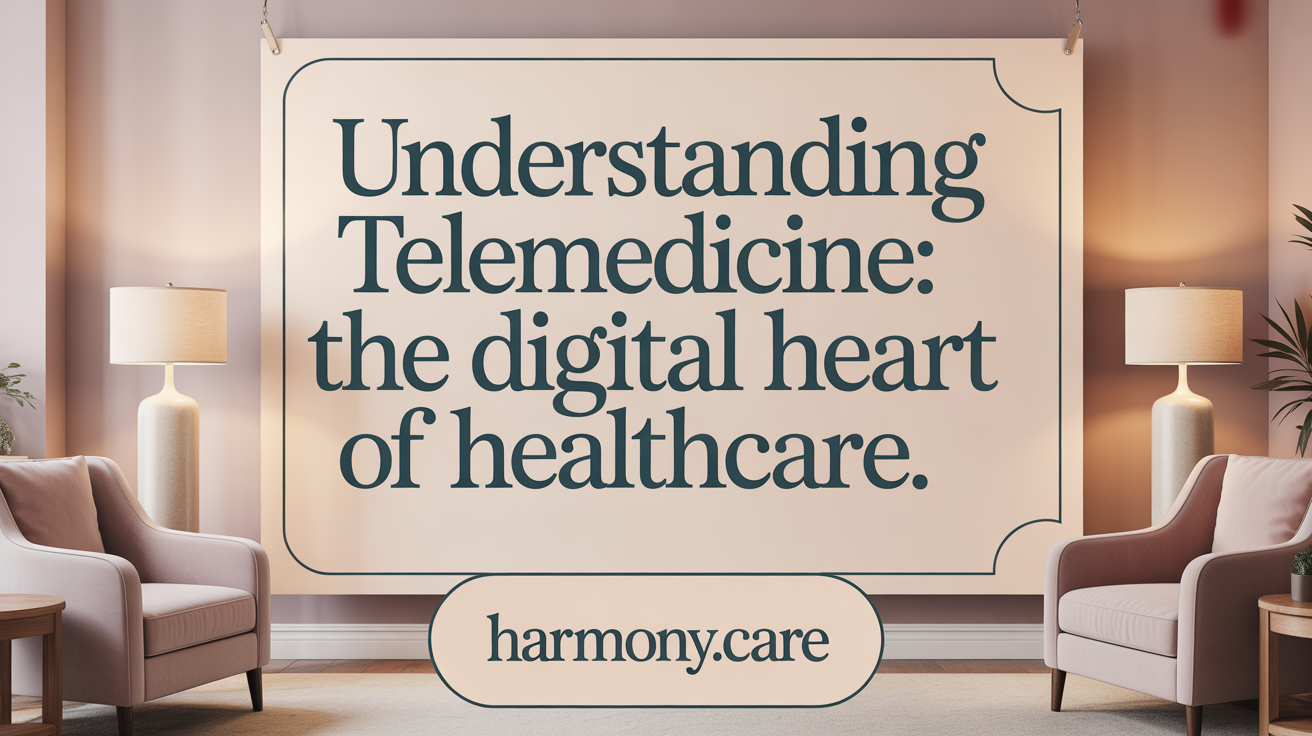Embracing Telehealth: A New Era for In-Home Medical Services
Telehealth is revolutionizing healthcare by bringing medical services directly to patients' homes, breaking down traditional barriers such as distance, mobility, and accessibility. Leveraging digital technologies, telehealth enhances patient engagement, improves outcomes, and creates a more efficient and patient-centered healthcare system. This article explores how telehealth expands access to in-home medical care, the technologies enabling it, the benefits it offers, the challenges it faces, policy implications, and future innovations shaping its trajectory.
Defining Telemedicine: The Foundation of Remote Healthcare

What is telemedicine?
Telemedicine, also known as telehealth, involves using digital technologies to deliver healthcare services from a distance. It bridges the gap between patients and providers by enabling remote consultations, diagnosis, and monitoring.
This approach encompasses a variety of tools, including video conferencing platforms, telephone calls, mobile health apps, and the transmission of medical data like blood pressure, blood sugar, or heart rate measurements.
Telemedicine serves both clinical and nonclinical functions. Clinically, it allows for medical consultations, follow-up care, and diagnostics without requiring physical visits. Non-clinically, it supports health education, administrative communication, and remote training.
Its primary goal is to improve access to healthcare, especially for those living in remote or underserved areas, reduce healthcare costs, and make healthcare more convenient for patients and practitioners alike.
However, telemedicine also faces limitations. It can be challenging to perform thorough physical exams remotely, which sometimes restricts diagnostic accuracy. Dependence on technology means that disruptions or lack of digital literacy can hinder effective delivery. Additionally, disparities in broadband access and device availability continue to pose barriers for certain populations.
Technologies employed in telemedicine
The range of tools used in telemedicine is broad and continues to evolve. These include:
| Technology Type | Functionality | Examples |
|---|---|---|
| Live Video | Real-time two-way communication | Zoom, Microsoft Teams, FaceTime |
| Store-and-Forward | Transmission of medical images and records for assessment | Email, dedicated medical platforms |
| Remote Patient Monitoring (RPM) | Collecting health data outside clinical settings | Wearable devices, mobile health apps |
| Mobile Health (mHealth) | Apps and SMS for health management | Medication reminders, health education apps |
| Artificial Intelligence (AI) | Data analysis, diagnosis support | Pattern recognition, symptom checkers |
The combination of these technologies enhances healthcare accessibility, especially for those unable to visit clinics physically.
Goals and constraints of telemedicine
Telemedicine aims to improve healthcare access, ensure continuous patient monitoring, reduce costs, and increase patient satisfaction. It plays a crucial role in managing chronic illnesses like diabetes, hypertension, and mental health conditions by enabling ongoing remote oversight.
Despite its advantages, telemedicine is not without challenges. These include ensuring data privacy and security, overcoming technological barriers such as poor internet access, and addressing regulatory hurdles across different regions. Moreover, certain assessments still require in-person physical examinations.
Future prospects involve integrating AI for smarter diagnostics, expanding broadband infrastructure, and refining policies to sustain telemedicine’s growth, making healthcare truly accessible to all.
How Telehealth Breaks Barriers to Access and Expands Care
How does telehealth increase access to healthcare?
Telehealth leverages digital technologies to deliver medical services remotely, making healthcare more accessible for everyone, especially those in remote or underserved areas. This approach helps eliminate the need for lengthy travel, saving patients time and travel costs.
One of the major strengths of telehealth is its ability to serve rural and isolated communities that traditionally face barriers such as limited local healthcare facilities or specialist availability. By utilizing virtual consultations and remote monitoring, patients can connect with healthcare providers from the comfort of their homes.
Telehealth platforms also support chronic disease management, including conditions like diabetes and heart disease. These technologies facilitate continuous engagement, allowing for regular check-ins and early intervention, which improve clinical outcomes.
Mental health services have seen a significant boost through telehealth, providing increased access to therapists and mental health professionals, especially during crises like the COVID-19 pandemic. Patients can access care without the burden of travel or exposure risks.
In emergencies or public health crises, telehealth ensures care continuity when in-person visits are limited or unsafe. Overall, by removing geographical and transportation barriers, telehealth enhances healthcare efficiency, quality, and equity, reaching populations that need it most.
Benefits of Telehealth for Patients and Healthcare Systems
What are the benefits of telehealth for patients and healthcare systems?
Telehealth significantly enhances healthcare accessibility and convenience for both patients and providers. It allows individuals, especially those living in remote or underserved areas, to receive specialized care without extensive travel, thus reducing costs and time spent on commuting. Virtual consultations and remote monitoring enable proactive, continuous care management for chronic diseases like diabetes, leading to better health outcomes and higher medication adherence.
Patients benefit from increased flexibility—accessing healthcare services round-the-clock, which reduces missed appointments and improves care continuity. For those with impairments, telehealth offers tailored solutions that respect privacy and accessibility needs, fostering greater engagement.
Healthcare systems see resource optimization through decreased hospital admissions, lower staffing costs, and more efficient use of infrastructure. The ability to triage patients remotely helps prioritize urgent cases and manage healthcare providers' workload effectively. Additionally, telehealth mitigates infection risks during pandemics by minimizing in-person contact.
Overall, telehealth promotes a more patient-centered, efficient healthcare experience. It expands reach, enhances patient satisfaction, and supports health systems in delivering high-quality care with optimized resource use.
Core Technologies and Mechanisms Enabling In-Home Telehealth
Telehealth relies on an array of advanced technologies and mechanisms to deliver healthcare services directly into patients' homes. The foundation includes virtual consultations through platforms like Zoom, Doxy.me, and other secure video conferencing tools, allowing patients to interact with healthcare providers in real-time. These live communications facilitate diagnoses, follow-ups, and therapy sessions without requiring physical visits.
Remote patient monitoring devices play a critical role by continuously collecting vital health data outside clinical settings. Wearable devices, such as fitness trackers and specialized medical sensors including blood pressure cuffs, glucometers, and ECG monitors, transmit patient information wirelessly to healthcare systems. This ongoing data flow enables clinicians to monitor conditions like diabetes or heart disease proactively, adjusting treatment plans as needed.
Patient portals are key to fostering ongoing engagement. These secure online platforms give patients direct access to their medical records, test results, and medication schedules. Patients can message providers, request refills, and review educational resources at their convenience, which streamlines communication and enhances care coordination.
Asynchronous communication tools supplement live interactions. Digital questionnaires, images of skin conditions, and store-and-forward reports enable providers to assess patient issues when real-time consultation isn't feasible, increasing flexibility and efficiency.
Importantly, all these mechanisms are integrated with Electronic Health Records (EHR) systems. Proper integration ensures that incoming data from devices, patient inputs, and healthcare provider notes are consolidated into a unified system, promoting accuracy, reducing errors, and facilitating seamless, continuous care.
Security also remains a priority. Telehealth systems adhere to strict data protection standards, ensuring that patient information remains confidential and protected against breaches. Collectively, these advanced tools and processes foster an effective, accessible, and secure in-home healthcare environment.
Telehealth’s Transformational Impact on Healthcare Delivery and Access

What is the impact of telemedicine on healthcare delivery and access?
Telemedicine has dramatically reshaped how healthcare is delivered, especially by increasing access for rural and underserved populations. Through remote consultations and digital health technologies, patients can now receive medical advice and ongoing care without traveling long distances. This reduces costs and time commitments, making healthcare more convenient.
The flexibility of telemedicine, including 24/7 availability, means patients can seek care at any time, enabling better management of chronic conditions and timely interventions. During the COVID-19 pandemic, its importance was further highlighted as it kept health services accessible while reducing infection risks.
Advanced tools like remote monitoring devices and shared electronic health records support better diagnostic accuracy and multi-provider collaboration. These innovations foster a more integrated and efficient system, leading to improved health outcomes.
Despite its many benefits, challenges such as digital literacy, infrastructure gaps, and data security need ongoing attention. As policies adapt to support telehealth, its potential to deliver high-quality, accessible, and patient-centered care continues to grow, transforming healthcare landscapes worldwide.
Challenges and Limitations of Telehealth in In-Home Medical Services
What are the disadvantages and challenges of telehealth?
While telehealth offers numerous benefits in expanding healthcare access and improving patient outcomes, it also faces several hurdles that can limit its effectiveness.
One major challenge involves regulatory and licensure barriers. Different states have varying rules and requirements, making it difficult for healthcare providers to practice across state lines seamlessly. This fragmentation can restrict patient access, especially in rural or underserved areas.
Reimbursement and financial challenges also impact the adoption and sustainability of telehealth services. Although coverage has improved, especially during the COVID-19 pandemic, many Medicare, Medicaid, and private insurers still have limited or inconsistent reimbursement policies for telehealth. This situation discourages some providers from offering virtual care.
Privacy and security concerns are increasingly prominent as cyber threats and data breaches pose risks to patient confidentiality. Telehealth platforms must employ robust security measures to safeguard sensitive health information, but implementing these can be costly and complex.
Technological and digital literacy issues further constrain telehealth utilization. Limited broadband access in rural regions, along with patients’ unfamiliarity or discomfort with digital tools, can hinder effective engagement. This digital divide particularly affects older adults and socioeconomically disadvantaged populations.
Another significant limitation is the inability to conduct thorough physical examinations remotely. Certain diagnoses require hands-on assessments, palpation, or specialized testing, which cannot be fully replicated through virtual visits. This limitation can affect diagnostic accuracy and treatment plans.
Finally, concerns around legal liability and the overall quality of virtual care persist. Providers may worry about malpractice risks or standards of care, which can influence their willingness to adopt telehealth solutions fully.
Overall, addressing these challenges is crucial to harness the full potential of telehealth, ensuring that it complements traditional care without compromising safety, effectiveness, or equity.
Policy and Implementation Factors Influencing Telehealth Adoption

What policy and implementation considerations affect telehealth in home healthcare?
The expansion of telehealth in home healthcare relies heavily on a well-structured policy framework that addresses several critical factors. Foremost among these are regulations that protect patient privacy and data security. Laws such as the Health Insurance Portability and Accountability Act (HIPAA) set standards for safeguarding protected health information, especially as digital tools and data-sharing platforms become more prevalent. Ensuring compliance with these regulations helps maintain patient trust and promotes safe use of telehealth services.
Reimbursement policies significantly influence telehealth adoption. Coverage parity laws, which ensure equal reimbursement for telehealth and in-person services, incentivize providers to incorporate virtual care into their practices. Additionally, health systems benefit from extended coverage of telehealth services, including during emergencies like the COVID-19 pandemic, which temporarily relaxed many restrictions. These adjustments are crucial for sustainable telehealth integration.
The ability of healthcare providers to practice across state lines has historically been hindered by licensure regulations. Efforts like interstate licensure compacts aim to facilitate cross-state practice, enabling clinicians to reach more patients remotely and easing provider shortages in underserved areas.
Another major consideration involves broadband infrastructure. Insufficient internet access remains a barrier, especially in rural and underserved communities. Policymakers are working on initiatives, such as broadband expansion programs, to improve equitable access. Addressing the digital divide is essential to prevent disparities in telehealth availability.
Post-pandemic, legislative bodies continue to update and extend telehealth flexibilities. This includes formalizing policies that support ongoing telehealth services, streamlining licensing procedures, and expanding services to encompass a broader range of medical disciplines.
Ultimately, successful telehealth implementation hinges on balancing regulatory compliance, financial incentives, provider flexibility, technological infrastructure, and efforts to promote health equity. These considerations collectively shape how telehealth can deliver safe, effective, and accessible care in the home healthcare setting.
The Vital Role of Virtual Visits in Enhancing In-Home Care Access

What is the role of virtual visits and telemedicine applications in enhancing access to in-home care?
Virtual visits, also called telehealth or telemedicine, utilize digital tools such as video conferencing, phone calls, and mobile applications to provide healthcare services remotely. This approach breaks down geographical barriers, making healthcare accessible to individuals in rural or underserved communities who might otherwise face significant travel challenges.
Through these virtual interactions, healthcare providers can conduct routine check-ins, monitor chronic conditions, and give medical advice without requiring patients to leave their homes. This continuous connection supports early detection of health issues and allows for timely interventions, which optimizes health outcomes.
Virtual visits also help reduce overall healthcare costs by cutting transportation expenses and decreasing the burden on healthcare facilities. They increase efficiency, enabling providers to serve more patients effectively while offering patients greater flexibility and convenience.
Effectively embedding telemedicine into home healthcare involves several steps. First, assessing whether the patient is suitable for virtual care is crucial. Educating patients on how to use telehealth platforms and providing ongoing technical support ensures smooth communication.
Additionally, healthcare providers must develop clear protocols for scheduling, documentation, and emergency procedures to maintain care standards. When properly integrated, virtual visits not only improve access but also enhance the quality, continuity, and satisfaction of in-home healthcare services.
Expanding Telehealth Benefits for Seniors and Special Populations

What are the benefits of telehealth for specific populations, such as seniors?
Telehealth plays a vital role in providing accessible, safe, and efficient healthcare for older adults. It enables seniors to 'age-in-place' by facilitating regular remote consultations, medication management, and ongoing treatment for chronic illnesses.
By reducing the need for frequent hospital visits and emergency room trips, telehealth cuts down healthcare costs and eases the burden on healthcare facilities.
Remote monitoring devices, such as wearable health sensors, allow healthcare providers to track vital signs like blood pressure, blood sugar, and heart rate in real time. This early detection capability helps intervene promptly, preventing complications.
Virtual health services also support mental health, offering telepsychiatry, counseling, and psychological support tailored to older adults' needs. Additionally, at-home palliative care and nutrition counseling improve overall patient satisfaction.
Services are often adapted to accommodate impairments, mobility issues, or cognitive challenges, ensuring that seniors remain engaged and active in managing their health.
Technological innovations, including AI-driven platforms and personalized digital applications, are expanding telehealth's potential to deliver highly tailored care.
In sum, telehealth furthers the goal of keeping seniors healthier, independent, and connected to healthcare providers without the stress and risks associated with traveling to clinics.
Supporting aging-in-place through remote monitoring
Remote monitoring technology enables continuous oversight of health parameters, providing early alerts for deteriorations. This supports independent living while maintaining safety.
Chronic disease management and mental health services
Telehealth offers robust management options for chronic conditions like diabetes, heart disease, and depression. Virtual therapy sessions and remote health coaching improve adherence and health outcomes.
Reducing hospital readmissions and ER visits
By facilitating early intervention and continuous monitoring, telehealth reduces unnecessary hospitalizations and emergency visits, which are costly and disruptive.
Tailoring services to accessibility needs
Customizable, user-friendly platforms ensure that services address specific impairments, language barriers, and cultural considerations, promoting equitable care for diverse populations.
| Benefit Area | Description | Impact |
|---|---|---|
| Accessibility | Easy-to-use interfaces for seniors and special needs | Increased engagement and compliance |
| Cost Savings | Reduces travel and hospital costs | Lower financial barriers |
| Continuous Care | Remote monitoring and virtual follow-ups | Improved health outcomes |
| Mental Health Support | Tele-mental health services | Better psychological wellbeing |
| Personalized Digital Platforms | Use of AI and tailored apps | Enhanced patient experience |
In conclusion, telehealth offers complex advantages for seniors and vulnerable groups, ensuring that healthcare is more inclusive, proactive, and patient-centered.
Continuity of Care and Patient Engagement Enhanced by Telehealth
How can telehealth improve continuity of care?
Telehealth offers a powerful way to maintain consistent contact between patients and healthcare providers. For individuals managing chronic diseases such as diabetes, regular remote consultations and virtual follow-ups enable continuous monitoring and early detection of potential complications. This ongoing communication helps keep care plans on track and reduces gaps in treatment.
Remote monitoring devices, like blood sugar trackers and blood pressure monitors, transmit real-time health data to providers, allowing for timely interventions without the need for in-person visits. This constant stream of information supports better medication management, adherence, and lifestyle adjustments. Moreover, virtual visits facilitate easier follow-up, so patients can report progress or concerns more frequently, fostering a proactive approach to health.
Telehealth also empowers patients through digital tools that enhance their understanding of their conditions and promote self-management. Patient portals, educational apps, and online resources provide accessible information, encouraging active participation in their healthcare decisions.
Addressing barriers such as transportation difficulties, mobility issues, or geographic isolation, telehealth extends the reach of healthcare services. Vulnerable populations, including the elderly and rural residents, benefit from this improved access, ensuring they receive timely and consistent care.
Ultimately, telehealth promotes a more integrated and continuous healthcare experience. It ensures patients receive steady support and guidance, which leads to better health outcomes and higher satisfaction. The seamless coordination enabled by digital health technologies is transforming traditional models of care into more patient-centered, convenient, and efficient practices.
Looking Ahead: Future Trends and Technological Innovations in Telehealth
The future of telehealth for in-home medical care is poised for exciting technological advancements that will transform patient experiences and healthcare delivery. One of the most significant trends is the integration of artificial intelligence (AI) and machine learning. These technologies will enable personalized treatment plans, enhance diagnostics, and automate routine administrative processes, making care more efficient and tailored to individual needs.
Wearable devices and remote monitoring technologies are expected to become more sophisticated, allowing continuous tracking of vital signs such as blood pressure, blood sugar, and heart rate. These tools will support proactive management of chronic diseases, reducing emergency visits and hospitalizations. Seamless integration with electronic health records (EHRs) will further improve care coordination, ensuring that all healthcare providers have real-time access to accurate patient data.
Emerging technologies like Virtual Reality (VR), Augmented Reality (AR), and even blockchain are predicted to play pivotal roles in the future. VR and AR can offer immersive patient education, remote surgical planning, and high-definition teleconsultations, expanding the scope of virtual healthcare services. Blockchain will enhance data security, providing a tamper-proof environment for sensitive healthcare information and ensuring patient privacy.
To support these innovations, advancements in network infrastructure, such as the rollout of 5G, will be essential. Faster, more reliable connectivity will enable high-quality video consultations and complex remote procedures with minimal latency. Moreover, the development of digital therapeutics—software-based treatments personalized to patient conditions—will broaden medication management and mental health interventions.
Addressing current challenges, ongoing efforts aim to improve equity in access to telehealth by bridging technological gaps and ensuring inclusive usability for diverse populations. Enhanced privacy and security measures will also be prioritized to maintain trust and meet regulatory standards.
Overall, these future directions will make home-based care more accessible, efficient, and effective, supporting a more patient-centered approach in healthcare systems worldwide.
Telehealth: A Gateway to Accessible, Efficient, and Personalized In-Home Care
Telehealth has emerged as a transformative force in enhancing access to in-home medical care, successfully bridging geographical, physical, and logistical gaps that have long challenged traditional healthcare delivery. By leveraging diverse technologies—from virtual visits and remote monitoring to AI-driven analytics—telehealth supports continuous, coordinated care tailored to individual needs. Despite challenges related to policy, infrastructure, and equity, ongoing advancements and thoughtful implementation strategies hold promise for overcoming these hurdles. As telehealth continues to evolve, it paves the way for a more accessible, efficient, and patient-centered healthcare future, particularly benefiting vulnerable populations such as seniors and rural residents. Its role in fostering health equity and improving outcomes affirms telehealth’s vital position in modern healthcare systems worldwide.
References
- How Telemedicine Is Improving Patient Outcomes and Expanding ...
- A Comprehensive Review on Exploring the Impact of Telemedicine ...
- Improving Access to Health Care: The Challenges & Potential of ...
- Telehealth and Health Information Technology in Rural Healthcare
- Telehealth Basics - ATA
- How telehealth is changing home health care - Wolters Kluwer
- Permanently expanding telehealth access will improve public health
